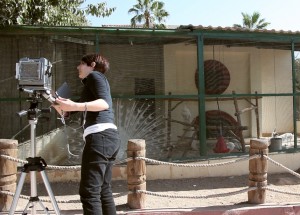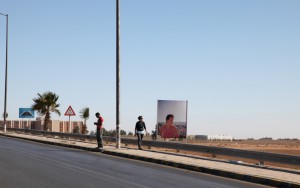
Regina Mamou, 2009-2010, Jordan, photographing on location in Shmeisani’s Prince Hashem Bird Garden, assisted by Bradley Heinz and Andrew Boylan (image by Regina Mamou).
My Fulbright journey in the visual arts began more than one year before I left for Amman, the capital city of Jordan. I first identified Jordan as the country to which I wanted to apply in June 2008 for the 2009-2010 Fulbright competition. Since graduating from the School of the Art Institute of Chicago (SAIC) with a Master of Fine Arts in Photography in 2007, I maintained connections with the Fulbright Program Adviser (FPA) at SAIC and with professors in photography, my field of study. Even though I applied At-Large, these individuals met with me on a regular basis to review my Statement of Grant Purpose and Personal Statement, and helped flesh out my research interests. I also formed an off-campus Fulbright group with three other SAIC students, which was a fruitful product of the application process. As a group, we met a few times each month to review our writing samples and offer one another support before the application deadline.
My interest in Jordan stems from my Middle Eastern heritage as my father was born and raised in Iraq. He was the first person in his family to immigrate to the United States. My extended family moved to Amman, Jordan, before they, too, eventually immigrated to the United States in the 1990s. Memory is an inherent quality of photography and I was interested in connecting with Jordan, a place that held familial significance. I began to conduct research on memory studies and navigation in Amman and was drawn to a weekly Internet-based column entitled, “Urban Crossroads,” by Mohammad al Asad, the founding director of the Center for the Study of the Built Environment (CSBE) in Amman. Reading these online articles allowed me to make abstract associations to the city, such as the fact that Amman only recently implemented house and street number addresses, and that residents have traditionally used a memory-based navigation system. This discovery led me to construct a Fulbright project about exploring navigational methods as a metaphor for interpreting a contemporary city, in addition to considering issues of architecture, urban planning, and population growth.
Expanding upon ideas that I discovered in Mohammad al Asad’s article, I developed my Fulbright project, “Mapping Collected Memory.” Using walking tours, an easy mode of transportation and a way for tourists to explore an unfamiliar city, I asked my friends, permanent and temporary residents of Amman, to take me on informal guided tours according to verbal directions, narrating routes that they have often traveled. Through this project, I learned about various landmarks that served as markers for navigators on their routes throughout the city. Using photography and video, I returned to document these landmarks and also created portraits of my guides in environmental settings. With a six-month Critical Language Enhancement Award (CLEA) in Arabic at Qasid Institute and Fulbright research for nine months, I lived in Amman for a total of fifteen months. Both components of my Fulbright grant helped me to adjust and become comfortable navigating the city.

Middle Photo: Regina Mamou, 2009-2010, Jordan, “Seven Hills” from the series “Mapping Collected Memory,” (2010), Digital C-Print (diptych), 40 inches x 64 inches, (image by Regina Mamou).
While in Amman, I worked with a variety of institutions including Darat al Funun, Makan Art Space and the Royal Film Commission (RFC). I also spoke with a number of emerging and established artists in Amman. Many of these individuals were from other countries, too, and I had the chance to speak with them about art in the United States as well as in their home countries such as Kyrgyzstan and Cameroon. This community of artists became my support system, and we would often meet up for coffee or chat on the Makan Art Space’s couches.
At the Royal Film Commission, I presented a workshop on photography for emerging Jordanian cinematographers and a lecture series with film screenings for RFC members. I also attended film screenings, exhibition openings, and lectures multiple times per week at different venues. These events allowed me to interact with Amman’s artistic community and find out about local as well as regional projects and conferences.
Part of my final project was presented in “The Utopian Airport Lounge: An Exhibition of Public Art Projects,” curated by Juliana Irene Smith and hosted by Makan Art Space in December 2010. Through this group exhibition, I created two large-format photographic installations. I also met with the other exhibiting international artists to regularly discuss project ideas and to help install and document the artwork.

Regina Mamou, 2009-2010, Jordan, installing one of her photographic sculptures for “The Utopian Airport Lounge: An Exhibition of Public Art Projects,” curated by Juliana Irene Smith and hosted by Makan Art Space (image by Juliana Irene Smith).
Since returning to the United States, I have shown select works from my Fulbright project in different exhibition spaces throughout the country. Additionally, the completed project, which includes a series of large-format color prints, was added to the Midwest Photographers Project, a rotating collection of portfolios in the Museum of Contemporary Photography at Columbia College Chicago in January 2012.
As an artist, I encourage individuals in the creative and performing arts to pursue Fulbright grants. It is an experience that can allow you to engage with your host community and to work independently on your project while receiving the support, encouragement, and assistance of an institution.
Tips for Fulbright Applicants in the Arts:
- When preparing your supplementary materials, I recommend that your portfolio speaks directly to the project that you intend to carry out in your host country.
- It will be useful to identify any logistical concerns or needs such as equipment, permits, and artwork assistance in your proposal. It is important to not only know what you will be making work about, but also how you intend to create it.
- Make sure your proposal avoids art jargon and craft a straightforward, succinct Statement of Grant Purpose. It was helpful to share my statement with artists who work in other media and with individuals who work outside of a creative discipline.
- Finally, if you receive a Fulbright grant, be prepared for your project to potentially change once you are in your host country. Be ready to adapt to these changes. As artists, we are faced with our final work being different from our original concept. This is just part of the process!
For more information about my Fulbright project, “Mapping Collected Memory,” please visit www.reginamamou.com.

1 Comment
You are so smart to do such a fantastic work.